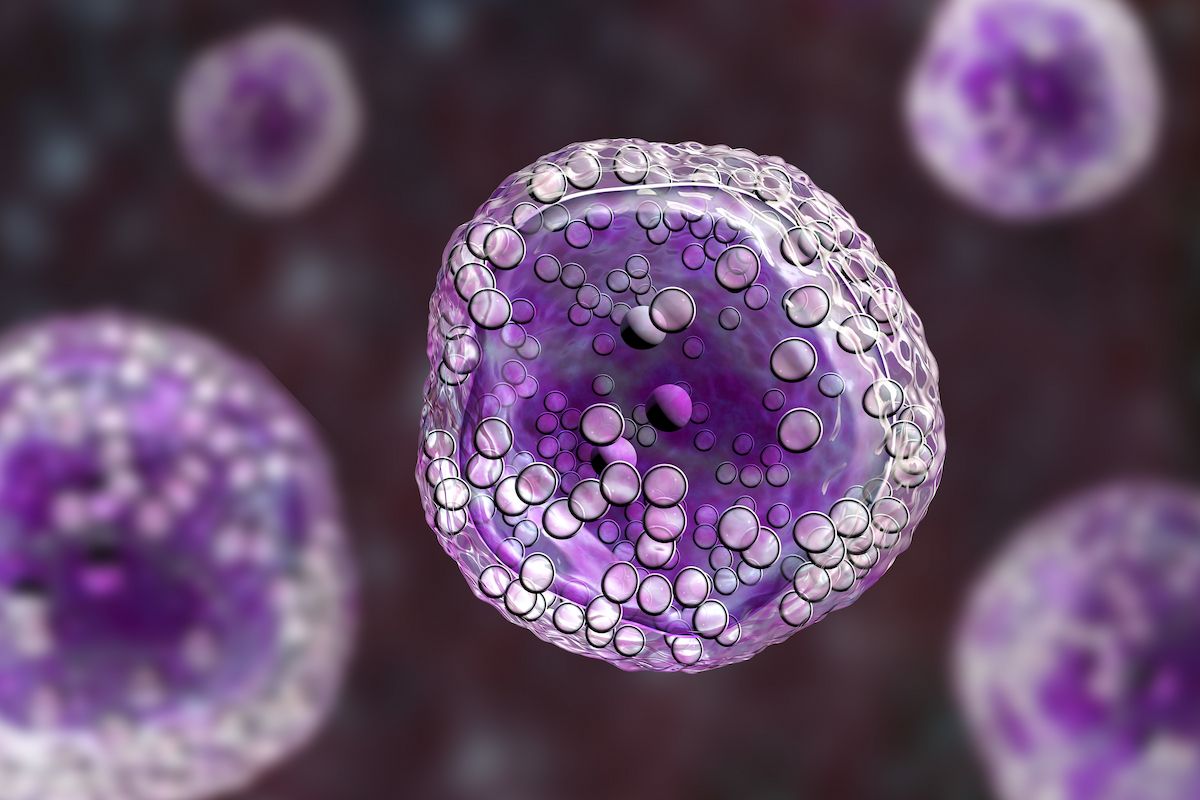Talquetamab Combo Data Warrant Further Research in R/R Multiple Myeloma
Findings from RedirecTT-1 show responses across different dose levels of talquetamab/teclistamab among those with multiple myeloma.
"On the basis of these results, this dual-targeting, off-the-shelf combination therapy warrants further investigation in patients with relapsed or refractory multiple myeloma," according to the study authors.

Although combining talquetamab-tgvs (Talvey) with teclistamab-cqyv (Tecvayli) increased the rates of high-grade infections among patients with relapsed/refractory multiple myeloma, the combination elicited enduring responses, according to findings from the phase 1b/2 RedirecTT-1 trial (NCT04586426) published in The New England Journal of Medicine.1
At the recommended phase 2 dose (RP2D), 80% (n = 35/44) of evaluable patients experienced a response at a median time to first response of 1.4 months (range, 0.3-5.1). A very good partial response (VGPR) or better occurred in 77% of patients, and 52% had a complete response (CR) or better.
Across all dose levels, the objective response rate (ORR) was 78% (n = 73/94), and the median time to first response was 1.8 months (range, 0.3-7.7). Additionally, 74% had a VGPR or better, and 48% had a CR or better. Investigators noted consistent responses across clinically relevant subgroups, which included most patients with extramedullary disease achieving a response (59%; n = 20/34).
The likelihood of a sustained response with the RP2D was 91% (95% CI, 75%-97%) at 12 months and 86% (95% CI, 66%-95%) at 18 months; the corresponding percentages were 86% (95% CI, 75%-92%) and 77% (95% CI, 64%-85%) across all doses. Among those with extramedullary disease, the probabilities of maintaining a response at 12 months and 18 months, respectively, were 82% (95% CI, 45%-95%) at both periods with the RP2D compared with 70% (95% CI, 45%-85%) and 52% (95% CI, 25%-74%) across all dose levels, respectively.
Any-grade infections occurred in 89% of patients, with grade 3/4 events affecting 64%.
“In this study, talquetamab plus teclistamab had a similar safety profile to each agent as monotherapy, although the observed incidence of grade 3 or 4 infections was higher with the combination than with talquetamab or teclistamab as monotherapies. Responses were observed across dose levels and were particularly deep and durable with the [RP2D],” Yael C. Cohen, MD, head of Myeloma Unit at Tel Aviv Sourasky Medical Center, wrote with study coauthors.1 “On the basis of these results, this dual-targeting, off-the-shelf combination therapy warrants further investigation in patients with relapsed or refractory multiple myeloma.”
In the ongoing, multi-center, open-label phase 1b/2 study, patients received escalating doses of subcutaneous talquetamab plus teclistamab in 28-day cycles. Dosing for talquetamab and teclistamab, respectively, included 0.2 mg/kg plus 0.75 mg/kg weekly in dose level 1, 0.2 mg/kg plus 1.5 mg/kg weekly in dose level 2, 0.4 mg/kg plus 1.5 mg/kg weekly in dose level 3, 0.8 mg/kg plus 1.5 mg/kg every 2 weeks in dose level 4, and 0.8 mg/kg plus 3.0 mg/kg every 2 weeks in dose level 5. Investigators ultimately selected dose level 5 as the RP2D.
The primary end point of the phase 1 portion was dose-limiting toxicity. Secondary end points included ORR, duration of response, time to response, pharmacokinetics, pharmacodynamics, and immunogenicity.
Patients 18 years and older with an initial diagnosis of multiple myeloma per International Myeloma Working Group criteria were eligible for enrollment on the trial.2 Other requirements for study entry included having relapsed/refractory disease after exposure to a proteasome inhibitor, immunomodulatory drug, and an anti-CD38 monoclonal antibody.
Overall, 94 patients were treated across all dose levels, and 44 received the RP2D. The median age in the overall population was 64.5 years (range, 39-81), and most patients were male (52%) and White (80%). Additionally, most had International Staging System class I disease (45%), an ECOG performance status of 1 (64%), triple-class–exposed disease (100%), and triple-class–refractory disease (86%).
The estimated 12-month and 18-month progression-free survival (PFS) rates were 74% (95% CI, 57%-84%) and 70% (95% CI, 52%-82%), respectively, using the RP2D. The PFS rate was 53% (95% CI, 28%-73%) at 12 and 18 months among those with extramedullary disease. Across all dose levels, the 12-month and 18-month PFS rates were 71% (95% CI, 60%-79%) and 62% (95% CI, 51%-72%), respectively.
Regarding other safety data, all patients (100%) had any-grade adverse effects (AEs), the most common of which included cytokine release syndrome (79%), neutropenia (73%), taste changes (65%), non-rash skin toxicity (61%), and anemia (56%). Grade 3/4 toxicities affected 96% of patients and consisted of neutropenia (68%), anemia (38%), and thrombocytopenia (30%), among others.
AEs leading to dose modifications and discontinuation of talquetamab and/or teclistamab occurred in 93% and 16% of patients, respectively. Investigators noted that 15% (n = 14) of patients died due to toxicity, which included pneumonia (n = 2), adenovirus infection (n = 1), COVID-19 (n =1), COVID-19–associated pneumonia (n = 1), John Cunningham virus infection (n = 1), aspiration pneumonia (n = 1), cytomegalovirus-related pneumonia (n = 1), respiratory tract infection (n = 1), sepsis (n = 1), septic shock (n = 1), cardiac arrest (n = 1), leptomeningeal myelomatosis (n = 1), and respiratory failure (n = 1).
References
- Cohen YC, Magen H, Gatt M, et al. Talquetamab plus teclistamab in relapsed or refractory multiple myeloma. N Engl J Med. 2025;392:138-149. doi:10.1056/NEJMoa2406536
- A study of the combination of talquetamab and teclistamab in participants with relapsed or refractory multiple myeloma (RedirecTT-1). ClinicalTrials.gov. Updated January 9, 2025. Accessed February 3, 2025. https://tinyurl.com/5asmmt5r
Newsletter
Stay up to date on recent advances in the multidisciplinary approach to cancer.